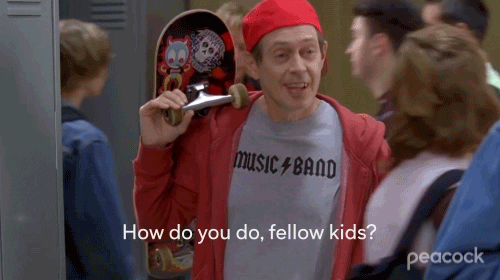Staying in touch with audiences
Why it's important to walk in your audience's shoes, even if they don't quite fit
I'm pretty comfortable with getting older. This article I read recently in The Atlantic highlighted how many people instinctively "feel" a different age from their actual one. That's not my vibe. I am 43 and feel that way, in body and soul. Being comfortable with getting older also means simultaneously getting comfortable with having to explain your cultural reference points and having to work harder to keep up with new references.
In a creative clinic recently, two colleagues and I got very excited about jumping on the 90s revival bandwagon and using a client event to celebrate the concept of "Cool Britannia" and the golden age of the mid-90s. Everyone else in the room was a fair bit younger than us; their memories of that period were completely different (and in some cases non-existent). Cue a hasty history listen and description of Liam and Patsy on the cover of Vanity Fair.
When it comes to staying relevant to current trends, in many ways, it's never been easier. You can follow many different newsletters, YouTube channels and IG/TikTokers to stay on top of what's hot. You can simultaneously feel old and disconnected from what’s trending but still know what everyone’s talking about. However, the trends that make you feel genuinely old are the slower, less noticeable shifts in behaviour. And as ever, these slower-moving trends are always the most interesting ones to focus on.
I came across one such trend in Ofcom's ever-excellent Children's Media Lives report, which made me feel way out of touch. According to Ofcom, large swathes of children instinctively turn to TikTok to find information on a topic.
I knew TikTok WAS a popular search engine, but I hadn’t realised quite how fundamental it is to children’s patterns of activity. It’s now habitual behaviour. Kids spend a large portion of their time on TikTok, so naturally, they go there first when they have a question about the world.
“I don’t know what to think…first I use TikTok and then if that doesn’t say anything, I’ll look on Google.” Amber, 10
That's a potentially tectonic shift in behaviour. So much of our work in the digital marketing and communications space incorporates a Google Search as a critical building block. Consumer journeys, corporate information, the reputation of individuals - plenty is built around what appears in the first couple of Google Search results. Search listening is a remarkably effective (and gloriously free) way of beginning a research project. The fact that 90-odd per cent of audiences use Google is taken for granted.
The next generation moving away from Google as their default search engine has potentially enormous ramifications for those of us working in marketing and communications (and also for kids themselves).
Now, of course, we need to remind ourselves before we get too carried away that we can read too much into what kids and teenagers do when they're young. One of the things about getting older is that we begin to assimilate into existing structures and behaviours. Many of the 21 kids aged 8-17 who took part in Ofcom's media lives study will enter the working world, and their primary device will become a laptop, not a phone. More and more of what they're required to look up will relate to their professional lives; kids already use Google for "specific information for their homework". There's definitely an argument that "work" will replace "homework" in that statement. Also, Google knows it has an existential threat from TikTok, and even if generative AI isn't the answer, you can bet they're working to come up with a response to the challenge.
But even if relying on social for search isn't a behaviour that sticks, it's a reminder that if we want to understand our audiences, we need to spend more time acting as they do. With 90% of the briefs we're working on, we are not the target audience. We can't assume shared behaviour. We need to get under the skin of how they act, consume media, and look for information.
We can’t, as with some news publications and their attempts at TikTok, try to impose our own ways of thinking and operating on audiences that are completely different from us.
And sometimes, as with TikTok in particular, that means getting comfortable with feeling uncomfortable. It means switching up our ingrained habits and trying on some new behaviour for size. It's always a tough ask. As human beings, we're conditioned to see everything through our own sphere of reference. As Daniel Kahneman calls it, what you see is all there is. And while TikTok and Instagram may not offer the same familiar UIs, or provide unfettered data access, they're still free to download and use. We can do our own audience safaris and walk in our target audience's shoes - no matter how different their generation might feel from our own.





